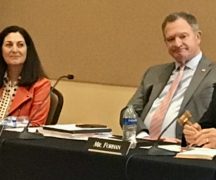By JAN LARSON McLAUGHLIN
BG Independent News
When COVID hit last year, many institutions started scrambling to cut costs. For Bowling Green State University, the result was the laying off of 119 employees and the furloughing of many more for up to 20 days.
Those cost saving measures led to many employees being shifted to other positions.
The disruption to daily operations was significant and employee satisfaction with the process and resulting job assignments was understandably poor, according to Sheri Stoll, BGSU vice president.
Looking back, more than a year later, university leadership can see the problems caused by BGSU’s reduction in workforce policy.
“One of the things we learned from that experience, is that the ‘bumping’ process was more painful than it needed to be,” Stoll told the university’s board of trustees on Thursday.
Staff members were “bumped” to positions they often did not have the skills to fill – which did not serve the university or the employees well.
So the trustees were asked to adopt a new Reduction in Workforce Policy for BGSU – in case such an emergency were to occur again in the future.
“Now that we’ve been through it,” Stoll said, some problems have been identified in the process. “It created tremendous disruption in our operations.”
The layoffs and “bumping” of staff to other positions was problematic for the university and for the employees, Stoll explained.
“It was a fairly unpleasant experience for almost everyone,” she said. “It was pretty awful.”
The new policy would be “more predictable and more acceptable to the departments and to individuals,” she said. The change would help staff being shifted to other positions, to land in jobs they had the skills and knowledge to perform. That would be better for employees and allow departments to function more smoothly.
The current policy at BGSU has never been modernized and reflects a time when classified civil service positions had less differentiation and did not require unique skill sets or knowledge of specialized software or associated processes.
The existing rules prescribe a “bumping” process when a position is identified for layoff or elimination. The bumping that occurred following the layoffs and position abolishment in May of 2020 extended through multiple rounds over approximately eight weeks and resulted in some classified employees landing in departments or divisions for which they had no or insufficient knowledge of specialized software or lacked certain skill sets required to perform successfully.
The most significant change in the new policy is the narrowing of the functional units into which a classified staff could be bumped to/from.
While this change will not entirely eliminate certain skill set mis-matching or lack of unique software experience, it does reduce the likelihood that a capable, trained employee will be bumped into a department or division for which the employee has no ability or knowledge to perform successfully.
The trustees approved the policy change.





